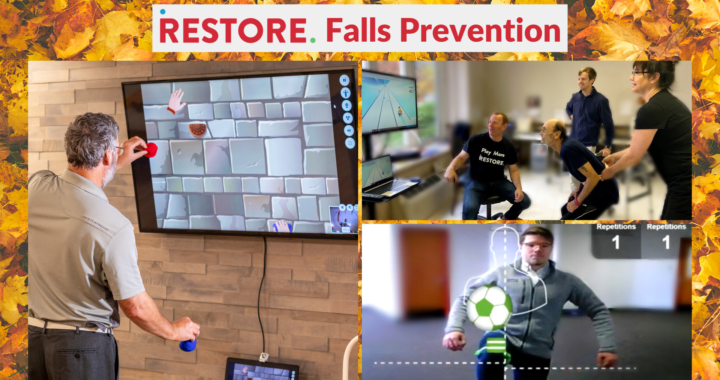Question:
How can we utilize RESTORE with our patients in support of falls prevention?
Answer:
Great question. To start we have to consider the physical and cognitive components required for a comprehensive falls prevention approach:
- Core and lower body strengthening (squats, lunges, etc.) to improve center of gravity control, stability to support sitting and standing
- Static and dynamic sitting and standing balance (no reaching, single extremity reach, bilateral hands-free isolated and integrated movement patterns)
- Weight-shifting, lateral mobility, forward/backward mobility
- Activity tolerance for posture, movement required for completion of self-care, leisure skills, home and community management
- Sustained attention, concentration, visual scanning, sequencing, safety awareness, decision making, following commands/direction
RESTORE can be used in support of each component. Progress can be accelerated by combining functional skill-building with immersive, interactive content (preferably person-centered based on the expressed interests of the player). Let’s consider the following:
- Game controllers calibrate to most red, green, blue objects.
- If working on functional reaching, select objects appropriate to maintain grasp/hand control or optimized for patients with only gross motor extremity control
- The calibrated controller for mobility should optimally have a center of the body placement (between chest and abdomen) so the player can maintain hands-free (especially if in need of assistive device)
- Calibrate the controller to color prior to securing on player
- 4” circular (red, green, or blue) stickers (most recommended)
- An object that can be attached via a clip to clothing
- Game settings and webcam settings can be graded based on the current physical and cognitive abilities of your player:
- Backgrounds can be adjusted for greater contrast or to simplify visual display
- Speeds and difficulty can be ranged from easiest to most difficult
- Music and effects can be varied for appropriate encouragement and engagement
- Range of motion capture can be reduced for players with limitations or expanded for those with full range capabilities
- Best for games challenging a combination of up/down, left/right, and diagonal movement patterns
- Best for games challenging a combination of up/down and left/right movement patterns
- Best for game challenging left/right movement patterns in sitting, and left/right, forward/backward movement patterns in standing
- Webcam setting options
- Full, medium, small screen capture
- Large, medium, small circular capture (narrows capture from square to circular configuration)
- Large, medium, small semi-circular capture (maintains top screen circular capture, but removes bottom screen circular capture requirement
Demonstrate intended movements and explain why they are critical components to limiting or preventing falls
- Patients are often fearful of falling. Having the ability to pattern their movements after seeing the therapist in action, can instill greater understanding and confidence
- Determine which skill areas you plan to target and match the game(s) with your plan. A few to consider with default game duration:
- Ski Saga (default is 3 minutes). Players can control a skier in a race by stepping/shifting left/right and squatting, or up/down, left/right upper extremity movements to avoid obstacles, slalom between flags, and obtain coins and gems. Bonus points awarded after 10+ successful obstacle navigations
- Ancient Temple (no set time limit). Players use both hands, sitting or standing, in an alternating up/down movement pattern to simulate rock climbing, with various integrated movement patterns included to challenge this treasure hunt adventure
- Spooky Spiders (default 3 minutes). Players utilize a dynamic, upper extremity or mobility, range to shoo away spiders of all sizes dropping/climbing vertically while watching out for a chance to knock a witch off her broom flying horizontally across the screen
- Bounce It (default 2 minutes). Players align with a silhouette, sitting or standing, and can use their knees, feet in an upward motion to connect and juggle a soccer ball.
When players (patients) are having fun and engaged they focus less on targeted skills and more on the game. They have less anxiety or frustration overcoming gravity and a fear of falling, when not focused on that fear every second. When a player demonstrates appropriate control, sustained action, adequate activity tolerance, and desired cognitive function that is when it is most beneficial to follow up a RESTORE session with a functional activity as they will now have the confidence to complete successfully.
